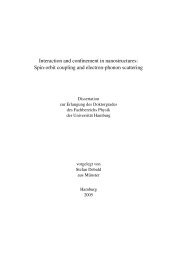Measuring the Electron Beam Energy in a Magnetic Bunch ... - DESY
Measuring the Electron Beam Energy in a Magnetic Bunch ... - DESY
Measuring the Electron Beam Energy in a Magnetic Bunch ... - DESY
Create successful ePaper yourself
Turn your PDF publications into a flip-book with our unique Google optimized e-Paper software.
2<br />
Σ<br />
t 0<br />
σ<br />
A<br />
σ<br />
ϕ<br />
2<br />
Σ t<br />
Accelerat<strong>in</strong>g<br />
Section<br />
2<br />
Σ t<br />
/ 2<br />
Figure 3.2.1<br />
Transformation of arrival-time jitter with an accelerator section followed<br />
by a bunch compressor.<br />
In Eq. 3.2.1, R 56 is <strong>the</strong> longitud<strong>in</strong>al dispersion constant of <strong>the</strong> chicane, C is <strong>the</strong><br />
compression factor of <strong>the</strong> bunch (def<strong>in</strong>ed <strong>in</strong> Sect. 2.3), A is <strong>the</strong> amplitude of <strong>the</strong> upstream<br />
accelerat<strong>in</strong>g voltage, ϕ is <strong>the</strong> phase of <strong>the</strong> accelerat<strong>in</strong>g gradient, and Σ t0 is <strong>the</strong> arrival-time<br />
jitter upstream of <strong>the</strong> accelerator section. It makes several approximations: <strong>the</strong> bunch is<br />
short relative to <strong>the</strong> wavelength of <strong>the</strong> RF, <strong>the</strong> <strong>in</strong>itial energy is small compared to <strong>the</strong><br />
energy after <strong>the</strong> accelerator section, <strong>the</strong> <strong>in</strong>com<strong>in</strong>g energy chirp is small compared to <strong>the</strong><br />
energy chirp ga<strong>in</strong>ed <strong>in</strong> <strong>the</strong> first accelerator section and <strong>the</strong> jitter is statistically<br />
uncorrelated. It was first published <strong>in</strong> [25] and a derivation is written <strong>in</strong> <strong>the</strong> Appendix A.<br />
The first th<strong>in</strong>g to notice about <strong>the</strong> equation, read<strong>in</strong>g it from left to right, is that <strong>the</strong><br />
<strong>in</strong>com<strong>in</strong>g arrival-time jitter, Σ t0 , is compressed <strong>in</strong> <strong>the</strong> chicane. The second th<strong>in</strong>g to notice<br />
is that at FLASH, <strong>the</strong> amplitude stability, σ A /A , of <strong>the</strong> klystron will be more critical than<br />
<strong>the</strong> phase stability, σ ϕ /c 0 k rf , for most typical values of σ A /A and σ ϕ /c 0 k rf . This becomes<br />
more apparent when typical values from <strong>the</strong> first bunch compressor of FLASH (BC2) are<br />
<strong>in</strong>serted <strong>in</strong>to <strong>the</strong> equation, giv<strong>in</strong>g:<br />
Σ after BC2 2 ≈ (0.2ps*0.1ps/ps <strong>in</strong>jector ) 2 +( 0.04*5.5ps/% gradient ) 2 + (0.01*2ps/deg phase ) 2<br />
With a compression factor of 10 <strong>in</strong> <strong>the</strong> first bunch compressor, <strong>the</strong> 200 fs <strong>in</strong>jector jitter<br />
would be compressed to 20 fs arrival-time jitter after <strong>the</strong> bunch compressor. The 0.04%<br />
gradient stability of <strong>the</strong> first accelerator section would limit <strong>the</strong> arrival-time jitter<br />
downstream of BC2 to 220 fs. The 0.01 deg phase stability of <strong>the</strong> first accelerator section<br />
would limit <strong>the</strong> arrival-time jitter downstream of <strong>the</strong> first bunch compressor (BC2) to 20<br />
fs. Given no additional contributions to arrival-time jitter from <strong>the</strong> second accelerator<br />
section amplitude or phase and fur<strong>the</strong>r compression of <strong>the</strong> <strong>in</strong>jector jitter by a factor of 2<br />
<strong>in</strong> <strong>the</strong> second bunch compressor, <strong>the</strong> arrival-time stability at <strong>the</strong> end of <strong>the</strong> mach<strong>in</strong>e<br />
would be limited by <strong>the</strong> first accelerator section to 220 fs. An improvement by a factor of<br />
10 <strong>in</strong> <strong>the</strong> gradient stability would make <strong>the</strong> arrival-time jitter contributions of <strong>the</strong> first<br />
accelerator section amplitude and phase approximately equal. The arrival-time stability at<br />
<strong>the</strong> end of <strong>the</strong> mach<strong>in</strong>e would <strong>the</strong>n be 30 fs rms. This calculation has, however, ignored<br />
<strong>the</strong> second accelerator section.<br />
Because of <strong>the</strong> assumptions of Eq. 3.2.1, one cannot simply use <strong>the</strong> equation<br />
recursively for <strong>the</strong> second accelerator section. For <strong>the</strong> second accelerator section, <strong>the</strong><br />
<strong>in</strong>com<strong>in</strong>g energy chirp is not small compared to <strong>the</strong> outgo<strong>in</strong>g chirp and <strong>the</strong> <strong>in</strong>com<strong>in</strong>g<br />
energy is not small compared to <strong>the</strong> outgo<strong>in</strong>g energy. Eq. 3.2.2 describes <strong>the</strong> arrival-time<br />
jitter after <strong>the</strong> second bunch compressor for a beam that is on-crest <strong>in</strong> <strong>the</strong> second<br />
26

















